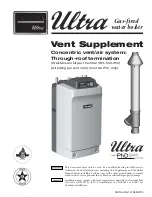
TROUBLESHOOTING
8-8
18. Disconnect the 1 ¾" connector from the
control panel, and wires #140 and #141 from
the ignition transformer.
19. Remove the cover plate from the AC wiring
box.
20. Referring to system schematic 161453 in
Appendix H, check wires #140 and #141 for
continuity.
21. If wires #140 and #141 have continuity,
inspect the pin on wire #140 in the 1 ¾"
connector for proper insertion or signs of
wear.
22. Inspect the connector on wire #141 at 1 ¾"
connector for a loose connection.
23. Make any necessary repairs.
24. After all wiring and connections have been
inspected or repaired, reconnect wires #140
and #141 to the ignition transformer.
25. Reconnect 1 ¾" connector to the control
panel.
26. Reinstall the cover plates on the ignition
transformer and the AC wiring box.
27. Be sure to reinstall the spark ignitor and
ignitor contactor if necessary and reconnect
the ignition cable to the ignition transformer
and the ignition contactor.
28. Reopen the leak detection valve.
29. Reconnect AC power to the unit and start
the unit.
30. If the flame fault still persists, replace the
combustion safeguard.
8.5.7 FLAME DETECTOR VOLTAGE
1. Disconnect AC power to the unit.
2. Remove the flame detector lead wire from
the flame detector.
3. Connect an AC voltmeter from the flame
detector lead wire to the frame of the unit.
WARNING!
A SHOCK POTENTIAL EXISTS. THE
FLAME DETECTOR LEAD WIRE HAS A
POTENTIAL OF 230 VAC.
4. Reconnect AC power to the unit.
5. An AC voltage reading of approximately 230
VAC should be observed.
6. If 230 VAC is observed, proceed to Section
8.4.2, Step 8.
7. If 230 VAC is not observed, disconnect AC
power to the unit.
8. Disconnect the 1 ¾" connector from the
control panel.
9. Referring to system schematic 161453 in
Appendix H, locate wire #135.
10. Check wire #135 for continuity.
11. Check the flame detector end of wire #135
for loose connections. Inspect the pins in the
1 ¾" connector for proper insertion and/or
signs of wear.
12. Repair if necessary.
13. If wire #135 has continuity and all
connections are okay or a repair was
performed, reconnect the flame detector
lead to the flame detector. Reconnect the 1
¾" connector to the control panel.
14. Reconnect AC power to the unit and start
the unit.
15. If the flame fault still persists, replace the
combustion safeguard.
8.5.8 RESIDUAL FLAME
Once the KC1000 has stopped firing, it
continues to monitor the flame circuit. If a
residual flame exists, the unit will indicate a
LOCKOUT fault. The source of a residual flame
is typically a leaking safety shut-off valve. To
check for a leaking safety shut-off valve proceed
as follows:
1. Shut the unit off by switching the ON-OFF
switch to the Off position
2. Locate the leak detection valve, between the
safety shut-off valve and the differential
pressure regulator.
3. Close the valve and remove a setscrew from
its 1/8” leak detection port.
4. Install an 8” or 16” manometer.
5. Monitor the manometer for signs of an
increase in gas pressure.
Summary of Contents for Benchmark G-00-711
Page 62: ...APPENDIX C ix Temperature Sensor Resistance Chart Balco ...
Page 69: ...APPENDIX F xvi ...
Page 70: ...APPENDIX F xvii ...
Page 71: ...APPENDIX F xviii ...
Page 72: ...APPENDIX F xix ...
Page 73: ...APPENDIX F xx ...
Page 74: ...APPENDIX G xviii ...
Page 75: ...APPENDIX G xix ...
Page 76: ...APPENDIX H xxi ...
















































